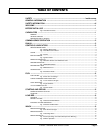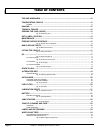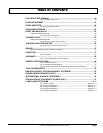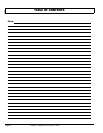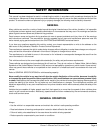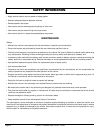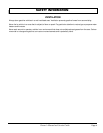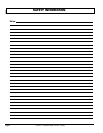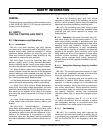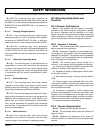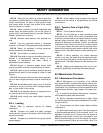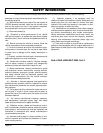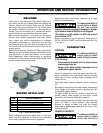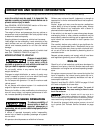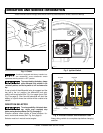
SAFETY INFORMATION
Page xi
Owner’s Manual and Service Guide
Read all of manual to become thoroughly familiar with this vehicle. Pay particular attention to all Notes, Cautions and Warnings
GENERAL
The following text is provided as recommended by part II
of SAE J2258 DEC 2003. E-Z-GO strongly endorses the
contents of this specification.
B.1 PART II
FOR THE CONTROLLING PARTY
B.1.1 Maintenance and Operations
B.1.1.1 Introduction
B.1.1.1.1 Like other machines, light utility vehicles
can cause injury if improperly used or maintained. Part II
contains broad safety practices applicable to vehicle
operations. Before operation, the controlling party shall
follow such additional specific safety practices as may
reasonably be required for safe operation.
B.1.1.1.2 Safety Survey-The controlling party shall
perform a safety survey of their premises periodically,
and as conditions warrant, identify areas where vehicles
should not be operated and to identify possible hazards.
(a) Steep Grade-In areas where steep grades exist,
vehicle operation should be restricted to the designated
vehicle's pathways where possible, and shall be identi-
fied with a suitable warning giving the following informa-
tion: “Warning, steep grade, descend slowly.”
(b) Wet Areas-Wet areas could cause a vehicle to lose
traction and could affect steering, stability and braking.
(c) Sharp Turns, Blind Corners, Bridge Approaches-
Sharp turns, blind spots, bridge approaches, and other
potentially hazardous areas shall be identified with a suit-
able warning to the operator of the nature of the hazard
and stating the proper precautions to be taken to avoid
the hazard.
(d) Loose Terrain-Loose terrain could cause a vehicle
to lose traction and could affect steering, stability, and
braking.
B.1.1.1.3 Utility Vehicle/Pedestrian Interference
Areas-Areas where pedestrian and vehicle traffic could
interfere should be avoided by rerouting the vehicle or
the pedestrian traffic to eliminate the interference. If elim-
ination of the interference is not possible or is highly
impractical, signs shall be erected warning pedestrians
and vehicle operators of traffic conditions and to use cau-
tion.
B.1.1.1.4 The controlling party shall train vehicle
operators to adhere strictly to the operating instructions
stated in vehicle operator's manual and those additional
operating instructions provided by controlling party.
B.1.1.1.5 The controlling party shall survey specific
operating conditions and environment, establish safety
practices, and train vehicle operators to comply with
these practices.
B.1.1.2 Operation Experience has shown that vehi-
cles which comply with the provisions stated in 7.8 are
stable when properly operated in accordance with spe-
cific safety rules and practices established to meet actual
operating terrain and conditions. However, improper
operation, faulty maintenance, or poor housekeeping
may contribute to a condition of instability and defeat the
purpose of the standard. Some conditions which could
affect stability are failure of the operator to follow safety
practices, surface conditions, grade, speed, loading,
braking, turning, improper loads, towing, attachments,
dynamic forces, and the judgment exercised by the vehi-
cle operator.
B.1.1.3 Nameplates, Markings, Capacity, And Mod-
ifications.
B.1.1.3.1 The controlling party shall maintain in a legi-
ble condition all nameplates, warnings, and instructions
which are supplied by the vehicle manufacturer.
B.1.1.3.2 The controlling party shall not perform any
modification or addition which affects capacity or safe
operation, or make any change not in accordance with
the vehicle manual(s) without the vehicle manufacturer's
prior written authorization. Where authorized modifica-
tions have been made, the controlling party shall ensure
that capacity, operation, warning, and maintenance
instruction plates, tags, or decals are changed accord-
ingly.
B.1.1.3.3 As required under B.1.1.3.1 or B.1.1.3.2,
the vehicle manufacturer shall be contacted to secure
new nameplates, warnings, or instructions which shall
then be affixed in their proper place on the vehicle.
B.1.1.4 Fuel Handling
B.1.1.4.1 The controlling party shall supervise the
handling of liquid fuels (when used) to be certain that it is
in accordance with appropriate sections of ANSI/NFPA
505 and ANSI/NFPA 30 or as required by local ordi-
nance.



